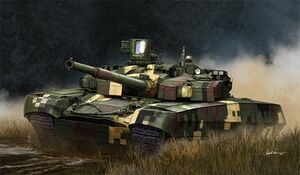YT-3 Crocodile MBT
This article is incomplete because it is pending further input from participants, or it is a work-in-progress by one author. Please comment on this article's talk page to share your input, comments and questions. Note: To contribute to this article, you may need to seek help from the author(s) of this page. |
| YT-3 Crocodile | |
|---|---|
 YT-3 Crocodile MBT on demonstration in Cordoba | |
| Type | Main Battle Tank |
| Place of origin | |
| Service history | |
| In service | 1999 - present |
| Used by | |
| Production history | |
| Designer | Martel Arms |
| Designed | 1991-1997 |
| Unit cost | $Y 9.2mil |
| Produced | 1999 - present |
| Specifications | |
| Weight | 57 tonnes |
| Length | 7.8m (hull) 12m (gun forward) |
| Width | 3.6 m |
| Height | 2.25 m |
| Crew | 3 (Commander, driver, gunner) |
| Armor | Classified composite alloy armor over stainless steel plate along with ERA and NERA modular add-on armor in addition to soft-kill and hard-kill APS systems |
Main armament | Entengo Marauder 120mm Smoothbore |
Secondary armament | Coaxial RK-25 "Shockwave" 25mm Autocannon and RWS-mounted GE-3 14.5mm heavy machine gun |
| Engine | Martel EM820v1 multifuel diesel (Block I) & Martel EM820v2 multifuel diesel-electric hybrid (Block II) 1,450hp |
| Suspension | In-arm suspension |
Operational range | 590 km on internal fuel and energy reserves |
| Speed | Up to 45mph (72km/h) on road, 33mph (53km/h) off-road |
The YT-3 Crocodile is a 3.5th Generation Main Battle Tank produced in Inyursta. Designed to replace Inyursta's aging fleet of Cold War legacy tanks, the YT-3 would go on to see widespread in a number of combat zones. Key features of the YT-3 include a modern smoothbore cannon, composite armor and advanced optical targeting systems.
Development
Design Features
Armament
The primary armament of the YT-3 Crocodile is the Entengo 120 "Marauder", a 120mm smoothbore cannon. A locally-produced clone of the Rheinmetall_Rh-120, the Crocodile typically uses the L/44 length cannon, though a small number of YT-3M3 units use the L/55 length and the YT-3M4 in use with the Inyurstan Marine Corps uses a shortened L/39 length to better fit into landing craft. A number of projectiles can be carried, including the N50A Armor-Piercing Fin-Stabilized Discarding Sabot (APFSDS) series, the N49N2 High-Explosive Squash Head (HESH), N62E1 SONIC guided anti-tank shell, and most NATO 120mm ammunition such as the M829. 42 rounds of ammunition are stored below the turret.
Secondary armament includes a coaxial 25mm autocannon, the RK-25 "Shockwave", for engaging lightly armored vehicles and infantry positions. Typically 100 rounds of 25mm are carried, though additional ammo is often stored externally. A topside 14.5mm heavy machine is mounted atop the turret. Block I models had this gun manned by the commander's position; however, following the Block II upgrade and production standard from 2010-2016 all manned guns were replaced with remote weapons systems (RWS) controlled from the safety of inside the tank while allowing enhanced imaging options to aim the gun.
Armor
Classified composite alloys form the backbone of the YT-3's base armor. While their composition is unknown, at least two separate material mixes are known to be used in a spaced armor array. The YT-3 is most protected on the front and sides of the turret, and the frontal glacis where the armor is thickest. Additional modular ceramic plates made of steel and syndite are applied to the rear sections of the turret, hull and sides.
Explosive Reactive Armor (ERA) can also be fitted to the vehicle, either across all surfaces or selectively those which are most vulnerable. Since its inception, the YT-3 has been fitted with PEVCOMS ERA, with later models utilizing either PEVCOMS-III or PEVCOMS-IV grade protection. Martel Arms has stated that certain types of foreign ERA can be retrofitted onto the YT-3.
The YT-3 Crocodile comes equipped with a number of active protection systems, including both hardkill and softkill. Current models use the Maelstrom Multi-Range Hardkill APS, a system using both short-range directed-energy ERA and a ballistic projectile to defeat incoming threats a wide variety of distances from the vehicle. The LIRDA Softkill APS uses a directed infrared beam to "dazzle" and confuse the warheads on laser and infrared guided warheads.
Performance
Block I Crocodile main battle tanks run on the Martel EM820v1 multifuel diesel engine, capable of putting out an estimated 1,300hp. Later Block II models use a newer Martel EM820v2 multifuel diesel-electric hybrid version capable of a slightly higher 1,450hp. Output allows for roughly 45mph on roads or paved surfaces, and 33mph on most off-road environments. The later EM820v2 also allows for improved fuel capacity, a primary concern when performing deep offensive advances into enemy territory.
To allow for greater angles of downward gun elevation, in arm-suspension is used.
Electronics
ESQ/GO-7 Electro-Optical Targeting software
History
Variants
Block I
YT-3A1: Basic Inyurstan service model produced in 1999.
YT-3A2: Additional ERA & slat armor added prior to deployment in the Lolloh-Ruol Wars
YT-3E: 2005+ Export model including steel in place of classified composites and additional soft-kill systems.
Block II
YT-3M1: 2010 Upgrade/production standard incorporating improved composite armor, electronics upgrades to allow for incorporation of infrared imaging optical targeting systems and Maelstrom Hard-Kill APS.
YT-3M2: Addition of PEVCOMS-IV improved reactive armor and system integration with the N62E1 SONIC guided shell.
YT-3E-M:" 2015+ Export model featuring earlier composite armor (post de-classification) and PEVCOMS-III ERA.
YT-3M3:" L/55 barrel length version.
YT-3M4:" L/39 barrel length version in use with the Inyurstan Marines.
Block III+
YT-3Z1: Proposed Next-Gen upgrades including...
YT-3PVF:(Plata Vehiculaire Furtivo) Experimental design incorporating an autoloaded 140mm ETC cannon.